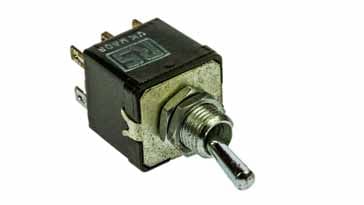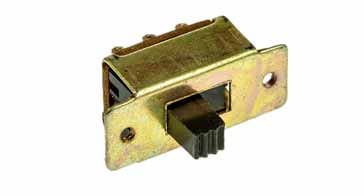Electromechanical Switches - Specifications & Parameters
When selecting any electromechanical switches for electronic circuits, it is necessary to ensure that it meets the performance requirements as set out in the specifications and parameters detailed in the data sheet.
Home » Electronic components » this page
Electromechanical Switch Technology Includes:
Electromechanical switches: basics
Specifications & parameters
Switch maintenance & repair
When selecting an electromechanical switch, often called and electronics switch for use with electronic or electrical circuits, it is useful to have a good understanding of the specifications and parameters.
Although the specifications and parameters for electromechanical switches are generally relatively straightforward, there are a few pitfalls.
Understanding the switch specifications will enable the correct switch with the right specifications to be chosen so that it can provide a long reliable life.

Electronics switch / electromechanical switch specifications
There are a number of parameters that are important when selecting a particular switch for electronics or electrical applications. The electrical capability along with the physical switching performance and the mechanical specification are all important.
Some of the key specifications and parameters are set out below with their explanations to provide an understanding of what they mean.
Voltage rating: This is the maximum voltage that the switch can withstand. It is determined by a number of factors including the insulation materials, the contact separation, the rate of separation, and general safety considerations. The voltage can also affect the switching action and contacts.
Under no circumstances should the rated voltage be exceeded and ideally a good margin left for unexpected surges, and to ensure the best long term reliability.
For switches that are used for switching alternating current, it is normal to quote the voltage rating in terms of the RMS voltage - this value is normally used for specifying AC voltages anyway.
Current carrying rating: The current specification for the electronics switches is of great importance, as the switch and its contacts will only be able to carry a certain level of current.
The rating of the maximum steady current that a switch can carry is normally that which it can carry through a closed contact. This is determined mainly by the heating effect (I2R) and it is generally greater than the current / power switching rating.
Current switching rating: The current switching rating for an electromechanical switch is normally less than the current carrying rating. The issue is that making and breaking a contact causes arcing and the contacts will only be able to withstand a certain degree of this before the wear on the contacts reduces the operating life to a large degree.
In most cases it is not possible for the current level to be reduced for the switching action to take place. Accordingly the lesser figure should be taken as the rating for the switch.
Inductive rating: Any inductance in a circuit will increase the level of arcing at the contacts and this will reduce the life of the switch if not handled correctly. As any inductance in the circuit will resist the change taking place, this means that once current is flowing, it is difficult to stop as the inductance will create large back EMFs when the current is stopped. This leads to arcing at the contacts and in turn this can result in burning of the contacts and a resultant increase in contact resistance.
The result of this is that the rating for a switch with an inductive load is much less than that for the switch with a resistive load. Transformers, motors and the like are very inductive, whereas other loads my be mainly resistive. It will be found that the specification ratings for a resistive load are much higher than those for an inductive load. Check the operating conditions and the specification before selecting any given switch, and err on the cautions side to ensure the reliability and life of the switch in the electronic circuit design stages.
Power rating: In some instances the rating of a switch may be given in terms of a power rating. This is typically specified in terms of volt-amps, VA or watts, W. The power rating is the maximum power that the switch can be handle while operating. Exceeding this rating can cause excessive heat to build up within the device, resulting in the potential failure of the switch as well a posing a safety hazard.
The power rating for a switch is normally given in terms of VA for AC loads where an inductive element may be present.
Contact resistance: As the contacts of a switch are not a continuous conductor, but are able to be broken and re-made, there is a contact resistance that is greater than if the conductor were continuous. In view of the fact that power Is dissipated in any resistance, or because even small levels of resistance can be important, it is sometimes necessary to consider the contact resistance of the switch.
- Number of operations: As the contacts of a switch move across each other to ensure that the best resistance is obtained, there is always a small amount of wear. Accordingly the performance of a switch will deteriorate after use. To quantify the useful life of a switch, the number of operations is sometimes quoted. This may be many thousands of operations.
Switch format: Selecting the right type of switch format is key for any electronics circuit design. There are many different switch formats: toggle switches, sliders switches, rotary switches, DIPs, thumbwheel and many more. The format is part of the selection process for any switch.
Contact type: For change-over type electromechanical switches, there are two types of contacts used and these will be detailed in the specification.
Break before make, BBM: The non-shorting changeover switches interrupt one changeover circuit before activating the other - this is the more commonly used form of changeover contact used in switches.
Make before break, MBB: The make before break form of switch contact temporarily shorts both circuits together during the switching process and it ensures that the contact connected to the pole piece is not left temporarily without a circuit to which it is connected. Although less common, this action can be very important in some circumstances.
It is important to selected the correct contact type for the electronics circuit design in hand. Selecting the wrong type could cause circuit malfunctions in some circumstances.
Environmental switch specifications: It is important to select a switch that will operate reliably in the environment that it will experience. There are several elements to an environmental specification for switches:
Temperature: Although temperature is not normally too much of an issue, the operating and storage temperature ranges should be borne in mind, especially where the equipment in which the switch is to be installed could experience extremes of temperature. Locations such as within automobiles, in hot countries, left in the sun, or even at the other end of the range where it may be exposed to the cold. Plastics from which switches are made can become distorted with extremes of temperature.
Moisture: Most ordinary switches are not waterproof, or even moisture-proof. If there is a requirement for the switch to operate in an environment where there is moisture or water, then switches capable of operating in these conditions must be used. The data-sheet specification for the switch will provide the relevant information.
IP ratings: IP ratings are defined under the international standard EN 60529 ( with parallel standards defined under British BS EN 60529:1992, European IEC 60509:1989). The IP ratings defined the 'Ingress Protection' and this relates to a variety of possible substances from dust to water and moisture.
Although some switches may have specifications detailing some form of moisture protection, the IP ratings provide an internationally recognised standard for this. Many electrical switches may have their specifications defined with the various IP ratings.
| Protection against solid objects | |
|---|---|
| First Number | Definition |
| 0 | No protection |
| 1 | Protected against solid items over 50mm (e.g. protects against touch by hands, etc). |
| 2 | Protected against touch by solid objects over 12mm (e..g. fingers). |
| 3 | Protected against solid objects over 2.5mm (e.g. tools, wires, etc). |
| 4 | Protected against solid objects over 1mm (e.g. thin wires and small tools). |
| 5 | Protected against dust - limited ingress only. |
| 6 | Totally protected against dust ingress. |
| Protection against liquids | |
|---|---|
| Second number | Definition |
| 0 | No protection |
| 1 | Protected against vertically falling drops of water. |
| 2 | Protected against direct sprays up to 15° from the vertical. |
| 3 | Protected against direct sprays up to 60° from the vertical. |
| 4 | Protected against sprays from all directions - some limited ingress permitted. |
| 5 | Protected against low pressure jets of water from all directions - limited ingress is permitted. |
| 6 | Protected against strong jets of water - some ingress permitted. |
| 7 | Protected against the effects of temporary immersion to a depth of between 15cm and 1 m. Maximum duration is limited to 30 minutes. |
| 8 | Protected against long periods of immersion under pressure. |
These IP ratings are used for a variety of items from electrical equipment to enclosures, and of course the y are very applicable to electromechanical switches.
Vibration: Under some circumstances vibration may be an issue. If the equipment in which the switch is to be used is in a vehicle or other environment where it will be subject to vibration, then the switch must have a vibration specification in its data-sheet. If it cannot withstand vibration, then it could become mechanically compromised and even fall apart, etc.
These represent some of the major switch specifications. There are more, and some will be applicable to various niche areas, but understanding these basic specifications will give a good insight into their performance.

The specifications for switches are important - being an electromechanical item, wear can accumulate and performance degrade over time if the switch ratings are exceeded. However if the margin for the ratings is too great, then a switch that is more costly than needed may be obtained, or it may be physically larger than is acceptable. Accordingly, a good understanding of the specifications is needed.
 Written by Ian Poole .
Written by Ian Poole .
Experienced electronics engineer and author.
More Electronic Components:
Batteries
Capacitors
Connectors
ADC
DAC
Diodes
FET
Inductors
Memory types
Phototransistor
Quartz crystals
Relays
Resistors
RF connectors
Switches
Surface mount technology
Thyristor
Transformers
Transistor
Unijunction
Valves / Tubes
Return to Components menu . . .



